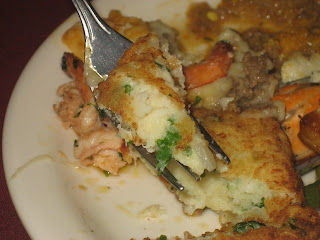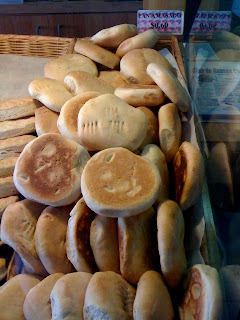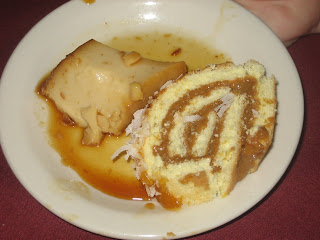When I think of Chilean comestibles, what comes to mind first is Chile’s burgeoning wine industry. One look at the map and you can see why wine has become a staple of the economy–there’s all that vino-riffic geography sandwiched between the Andes and the Pacific Ocean where they’ve been creating wine since the era of the Spanish conquistadors. But what about the food? Time to find out!
Rincon Chileno on Melrose (close to L.A. City College) is one of those mom-n-pop places that local Chileans flock to, so I figured it would be a good place for us to sample the native fare. Himself and I walked in and essentially fell facedown on the buffet. It looked like the locals were doing the same, so we didn’t feel out of place at all. However we did stand out, because we were the only people there who, with our blue eyes and fair features, were obviously not from the neighborhood. It’s a good sign that you’re in an authentic restaurant when you don’t look like you could blend in.
I apologize for this unglamorous photo of a rather beastly looking pile of “a little bit of everything,” but when you want to get a feel for–and a taste of–a country’s cuisine, a buffet is a helpful thing, visual appeal be damned!
A big ol’ mmmmessy buffet plate, complete with three presentations of potatoes.
I’ll take this clockwise-ish and point out some items of note: At 12:00 is the potato patty, which was filled with scallions and fried. It reminded me a lot of Irish boxty. At 1:00 are camarons, shrimp. At 3:00 is pastel de papas, a ground beef and potato pie that looks like the Chilean take on the English shepherd’s pie; at 4:00 is pastel de choclo, a ground beef and corn pie with egg and black olives; at 8:00 are beef and mushrooms in a brown sauce. All three of these were rich and satisfying. At 10-11:00, providing a fresh, bright counterpoint to all the richness was the standard Chilean salad of tomatoes and green beans. In the middle are mussels topped with cheese and a pastry filled with ham and cheese. While everything was flavorful, nothing was spicy at all. Even though we encountered this a few weeks ago with Colombian food, it’s still a surprise to me. Silly, but my tummy-mind still believes that if it’s a food from south of the US, it must be spicy.
What was NO surprise was finding potatoes in three forms on my plate. Honestly, I thought there would be even more, since this is the part of the world that gifted us with the potato.
This potato and scallion fried patty reminds me of Irish boxty.
Himself’s plate: Some repeats, but I wanted to show you that big ol’ generous portion of whiting fish stretched across the center of the plate. This was actually one of the smaller pieces!
Also surprising was the casualness with which the fish and seafood were tossed in with everything else. Typically buffets showcase seafood, treat it like royalty and set it off on its own, sometimes even providing a plate specifically for it. I found it rather refreshing that it was included so easily, as if they’re saying, “Yes we have meat and veg, but our coastline is so expansive that we have plenty of seafood to share.” The bounty was certainly evident in those honkin’ big pieces of whiting fish, called merluza frita. It’s a meaty fish with a clean taste, rather like halibut, but just a bit lighter.
pan amasado, in the attached bakery next door
Accompanying our meal was pan amasado, a Chilean bread made with lard. It has a smooth exterior and an inside that is flaky like a biscuit. The texture and flavor are biscuity as well. Their size and shape make them the perfect Chilean sandwich bread.
All this and a robust glass of sangria, and you’d think we’d be set for the day. But no, there’s always dessert to be reckoned with…
Flan & Brazo de Reina–“Arm of the Queen”
Some desserts to sample later.
Most of the desserts were heavy on caramelized sugar and sweetened, condensed milk. Flan is the best known example of this–it’s a pretty standard dessert throughout the Latin regions. The Brazo de Reina, or “arm of the queen” looked like a jelly roll, but it was filled with sweetened, condensed milk that had been cooked down to a thick creamy caramelized paste. Alfajor, the sandwich cookie to the left, is made of melt-in-your-mouth cookies with dulce de leche inside; the other two (I didn’t catch their names) are puff pastries such as you’d find in any European bakery. The one in front was topped with jelly. The roll of pastry to the right was filled with dulce de leche, too, similar to the “queen’s arm” except that it was made of puffed pastry leaves rather than cake. All were good in that tooth-achy sort of way that sends you scrambling to the dentist!
tres empanadas with pebre
We also carried away an array of empanadas, which made excellent lunches this past week. All were baked, rather than fried, and all were savory, no sweets in the bunch. To the right is a spinach and cheese empanada; at the bottom, chicken (my personal fav); and at the left, beef and egg. The substantial crust around them–especially on the beef empanada–reminds me of those on England’s Cornish pasties, nifty handles for eating your meal without making a mess. For both flavor and ease of consumption, these put the American fast food and frozen food versions to shame. Every crinkle, every fold was made by hand. Machines just can’t put into them what the human touch does. The pebre, a salsa verde, is pretty warm stuff, the only truly spicy element in the entire meal. Our server set a large bowl of it on the table when she brought the sangria and pan amasado. It essentially goes well on anything, except maybe dessert. When the owner boxed up our empanadas-to-go, he gave us a generous supply as well.
I found an item in the news just this week about the spat between Chile and Peru in which both claim to be the birthplace of the potato. My blog entry from the previous week mentioned the Malaysian and Indonesian quarrel over food, so I guess everyone needs bragging rights to something. (I’m from Memphis, and while I know barbecue wasn’t invented there, I do think ours is the best!) But when food is such an important vehicle for peace, for sitting at table and breaking bread together, it’s a shame to get into a snit over where it came from. If there’s going to be a food fight, how about executing it in a much more fun way, perhaps in the style of Animal House?






















